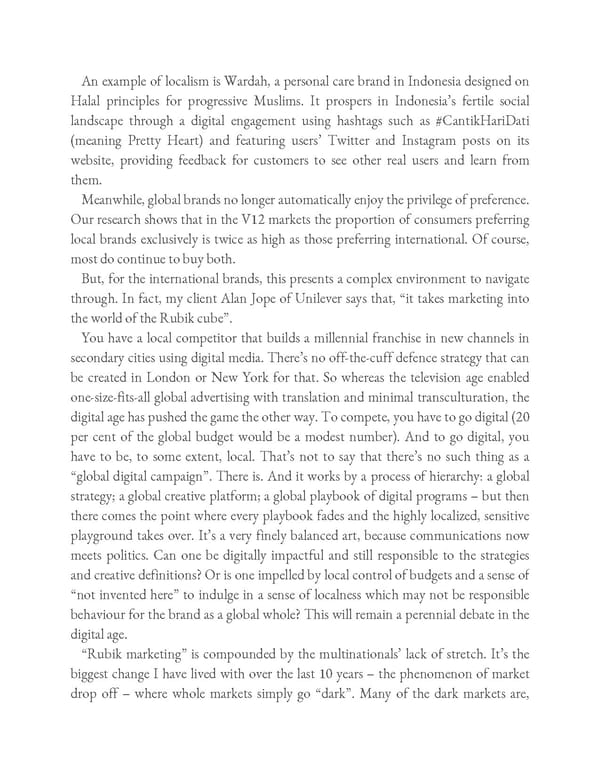An example of localism is Wardah, a personal care brand in Indonesia designed on Halal principles for progressive Muslims. It prospers in Indonesia’s fertile social landscape through a digital engagement using hashtags such as #CantikHariDati (meaning Pretty Heart) and featuring users’ Twitter and Instagram posts on its website, providing feedback for customers to see other real users and learn from them. Meanwhile, global brands no longer automatically enjoy the privilege of preference. Our research shows that in the V12 markets the proportion of consumers preferring local brands exclusively is twice as high as those preferring international. Of course, most do continue to buy both. But, for the international brands, this presents a complex environment to navigate through. In fact, my client Alan Jope of Unilever says that, “it takes marketing into the world of the Rubik cube”. You have a local competitor that builds a millennial franchise in new channels in secondary cities using digital media. There’s no off-the-cuff defence strategy that can be created in London or New York for that. So whereas the television age enabled one-size-fits-all global advertising with translation and minimal transculturation, the digital age has pushed the game the other way. To compete, you have to go digital (20 per cent of the global budget would be a modest number). And to go digital, you have to be, to some extent, local. That’s not to say that there’s no such thing as a “global digital campaign”. There is. And it works by a process of hierarchy: a global strategy; a global creative platform; a global playbook of digital programs – but then there comes the point where every playbook fades and the highly localized, sensitive playground takes over. It’s a very finely balanced art, because communications now meets politics. Can one be digitally impactful and still responsible to the strategies and creative definitions? Or is one impelled by local control of budgets and a sense of “not invented here” to indulge in a sense of localness which may not be responsible behaviour for the brand as a global whole? This will remain a perennial debate in the digital age. “Rubik marketing” is compounded by the multinationals’ lack of stretch. It’s the biggest change I have lived with over the last 10 years – the phenomenon of market drop off – where whole markets simply go “dark”. Many of the dark markets are,
 Ogilvy on Advertising in the Digital Age Page 450 Page 452
Ogilvy on Advertising in the Digital Age Page 450 Page 452